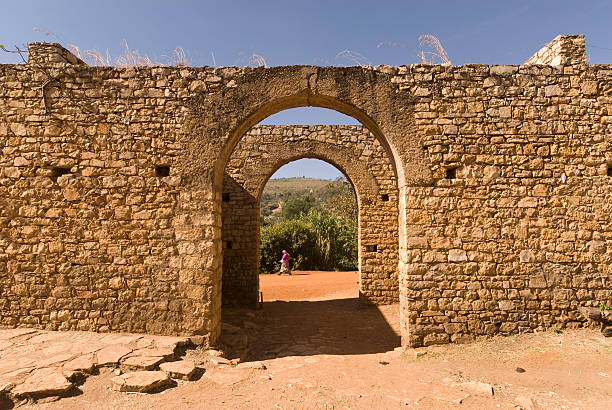Manuscript Coming Soon!
-
Extract From Documents of Foreign DiplomacyDate:Extract : from several Volumes Contributor ; Abdulahi Sherif Note : Pleae read " Barar " as" Harar " , " Majour Bunter " As " Majour Hunter " ( electronic tranlation error)
-
Press Release - ESAT’s PrejudiceDate: August 17, 2018Press Release The Global Harari Unity Advocacy Council believes that democracy exists only with a free and unfettered press. The Council does not agree with a press that disseminates false and unfounded information that could have the potential to ignite violence, as we repeatedly witnessed a broadcast through the so-called ESAT television network that has declared open war on the legitimacy of the Harari State. Though this outlet is known to be an equivalent of the old Pravda propaganda machine of the Soviet era, it has to be identified for what it stands for- to promote the supremacy of Amhara culture and tradition over every region that has been annexed through the territorial aggrandizement policy of their emperors. ESAT, certainly represents the worst in media practice, having justified its hidden agenda that stands on the way of the peaceful coexistence of peoples by broadcasting unfounded and often out of sync information
-
A PREJUDICED DEMEANOUR-Date: November, 2019A PREJUDICED DEMEANOUR Habetamu Ayalew's Misappropriated Journalism of(Hear it all from me, Takeit from me &Believein me, I know it all!)and His Repulsive perception on Harar " In a sound journalistic platform, a responsible media strives to impart and deliver a discourse on a subject matter responsibly enough having correct background information be it on verbatim, recorded archived history or self physical observations without favour and bias. It is hoped that Ethio360media does endeavour to uphold journalistic etiquette and dictum of do not cause harm and do not infringe on the rights of others nor be the vessel for disharmony, disgruntlement and misgivings rather strives to maintain the highest standard of neutrality. Nevertheless while acknowledging the right of freedom of expression which is as well premised within a context of responsibility in imparting informations in its actuality and truthfulness, Having heard Habetamu Ayalew's narration such unwarranted vilification on the people of Harar and selectively on Abdella Sherif shouldn't be ignored as it is inflammatory, prejudicial, bias, defamatory and demeaning having an ulterior motive to garner political expediency and malicious intent." <strong
-
Council For An Autonomous Jewish Province in HarrarDate: 1938-1944Correspondence Letteres between Jewish council, US, and Ethiopia ......My proposal is to unite the so-called HARRAR-territory of Ethiopia with part of British-Somaliland and create there a state for the European Jews.....
-
THE INFLUENCE OF ARAB AND ASIAN TRADERS ON HARARI MUSIC AND CULTURAL IDENTITYDate: December 6, 2023The objective of this study is investigating how and why the Harari peoples Music and cultural Identity isdifferent from the other parts of the Ethiopian people. This study has mainly focused on the forms and thescale and why this scale or music, forms and cultural identities are different from the other parts of Ethiopia.
-
Land ownership in Hararge ProvinceDate: June, 1966
-
Dil Shahan ( ዲል ሸሀን )Date: 2007-NovOር መህጂጃች 2 , ሐድነት 4 ,ጅምጅምቲ ሞ ድምድምቲ 6 , ሩህኻድ Aለፉው 7, Uመት ሂልቂ 10 , Oር መህጂጃሌ ዚትሰጠ 13 ኮOት ኣዳው መትጋበት 15, ኣው Aባድር ሐረሪ ወለባይ 16 , ሐረሪ መሀድ ኮንግረስ ዲያስፖራቤ 18 _x000D_
-
Khat culture and economic wellbeing: Comparison of a chewer and non-chewer families in Harar cityDate: Nov, 2020This study contributes to the debate on khat by comparing the family wellbeing of khat chewer (consumer) and non-chewer families in Harar city, by using the International Wealth Index’s (IWI) characterization of wellbeing. The study utilized the survey method. Respondents were identified using a cluster sampling method. The data was gathered using an interview schedule, in-depth interviews, and non-participant observation...
Randomly Generated
-
 The Significance Of Harari MusicDate: 2010College of Education, Addis Ababa UniversityABSTRACTThe purpose of this article is to show that cassette and CD recordings of Harari pop songs are significant and useful in promoting public policies in the education and culture sectors. The method employed for this study is both quantitative and qualitative analysis. The study is based on Harari songs released on seventeen cassettes or CDs, and is supplemented by an investigation of objectives set forth in Ethiopia’s Culture Policy, and Education and Training Policy. Purposive sampling was considered and categories were delineated for the songs as well as the objectives of the policies. Then the core messages of the songs were compared with the objectives of the policies. The education and Training Policy while eleven songs reflected the Cultural Policy. The core message of these and similar songs may best be evaluated in terms of the overt and subtle contributions of musical expressions in preserving local knowledge; they can be useful in promoting education, protecting cultural heritage, and maintaining societal norms and values.
The Significance Of Harari MusicDate: 2010College of Education, Addis Ababa UniversityABSTRACTThe purpose of this article is to show that cassette and CD recordings of Harari pop songs are significant and useful in promoting public policies in the education and culture sectors. The method employed for this study is both quantitative and qualitative analysis. The study is based on Harari songs released on seventeen cassettes or CDs, and is supplemented by an investigation of objectives set forth in Ethiopia’s Culture Policy, and Education and Training Policy. Purposive sampling was considered and categories were delineated for the songs as well as the objectives of the policies. Then the core messages of the songs were compared with the objectives of the policies. The education and Training Policy while eleven songs reflected the Cultural Policy. The core message of these and similar songs may best be evaluated in terms of the overt and subtle contributions of musical expressions in preserving local knowledge; they can be useful in promoting education, protecting cultural heritage, and maintaining societal norms and values. -
 Lines on the classification of Ethiopian-SemiticDate: 1996AbstractEthiopian-Semitic constitutes a compact, readily defined and homogeneous linguistic family, consisting of Ge' ez, Tigre, Tigrinya, Amharic, Argobba, Harari, Gafat, and the Gurage cluster. The most recent attempt to set up a classification of Ethiopian-Semitic was Hetzron [1972}, but this work was rather thoroughly criticized by Goldenberg [1977], and the field has yet to recover from it. The present note seeks to open the classification question anew by providing a basic, minimalist classification scheme, which can serve as a starting-off point for any future work on the subject. We begin with some of the results of Marcel Cohen [1931], "the father of Ethiopian studies" in the twentieth century. Cohen treats Tigre and Tigrinya as Northern Ethiopic, and Amharic, Harari, and the Gurage cluster as Southern Ethiopic. All are ultimately descendants of a ProtoEthiopic koine most closely resembling Ge'ez. Gurage, according to Cohen, is not a language or a linguistic unit in itself, but rather an ensemble of at least two separate and mutually unintelligible dialect clusters, Eastern Gurage and Western Gurage. Eastern Gurage consists of Wolane, Selti-Ulbarag, (and in the present state of our knowledge also Zway) , and is most closely connected with Harari. Western Gurage consists of several subgroups of dialects, in particular (a) Chaha, Ezha, Ennemor (Inor), Gumar, Gyeto (and in the present state of our knowledge Endegefi) and (b) Muher, Gogot, Masqan. Aymallel (Soddo, Kgstangiiiia), another Gurage tongue, is left unclassified by Cohen, as being perhaps intermediate between the two groups. Tentatively, he terms it North-Eastern Gurage. (Gafat and Argobba are not classified by Cohen.)
Lines on the classification of Ethiopian-SemiticDate: 1996AbstractEthiopian-Semitic constitutes a compact, readily defined and homogeneous linguistic family, consisting of Ge' ez, Tigre, Tigrinya, Amharic, Argobba, Harari, Gafat, and the Gurage cluster. The most recent attempt to set up a classification of Ethiopian-Semitic was Hetzron [1972}, but this work was rather thoroughly criticized by Goldenberg [1977], and the field has yet to recover from it. The present note seeks to open the classification question anew by providing a basic, minimalist classification scheme, which can serve as a starting-off point for any future work on the subject. We begin with some of the results of Marcel Cohen [1931], "the father of Ethiopian studies" in the twentieth century. Cohen treats Tigre and Tigrinya as Northern Ethiopic, and Amharic, Harari, and the Gurage cluster as Southern Ethiopic. All are ultimately descendants of a ProtoEthiopic koine most closely resembling Ge'ez. Gurage, according to Cohen, is not a language or a linguistic unit in itself, but rather an ensemble of at least two separate and mutually unintelligible dialect clusters, Eastern Gurage and Western Gurage. Eastern Gurage consists of Wolane, Selti-Ulbarag, (and in the present state of our knowledge also Zway) , and is most closely connected with Harari. Western Gurage consists of several subgroups of dialects, in particular (a) Chaha, Ezha, Ennemor (Inor), Gumar, Gyeto (and in the present state of our knowledge Endegefi) and (b) Muher, Gogot, Masqan. Aymallel (Soddo, Kgstangiiiia), another Gurage tongue, is left unclassified by Cohen, as being perhaps intermediate between the two groups. Tentatively, he terms it North-Eastern Gurage. (Gafat and Argobba are not classified by Cohen.) -
From Fascism : The Politics Of Change in Harar's City Form , 1930-2011Date: 2011Pictorial Description of Change of The City.(EH annotation)










